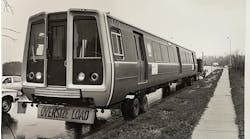The California High-Speed Rail Authority has released the Final Environmental Impact Report/Environmental Impact Statement (Final EIR/EIS) for the Bakersfield to Palmdale section of the state’s high-speed rail system.
The document will be presented to the authority’s board on Aug. 18-19 for approval. Should the board approve the Final EIR/EIS, it will be the high-speed rail system’s third approval of an environmental document in two years.
In 2019, the Federal Railroad Administration (FRA) granted the state of California permission to perform the needed environmental reviews for the project – just as the state does for highway projects. At the time, the authority said the move to state oversight would allow the environmental reviews to be completed more efficiently.
The 80-mile Bakersfield to Palmdale project section would be the first high-speed rail segment in Southern California to be environmentally cleared. The authority also notes the milestone moves the project section closer to being “shovel ready” for when preconstruction and construction funding become available.
“This environmental document is a culmination of thoughtful study and collaboration with partner agencies, city and county leaders, community members and other stakeholders,” said Authority CEO Brian Kelly. “With this effort, California will have 300 of the 500-mile high-speed rail system environmentally cleared, paving the way for future construction progress into Los Angeles County.”
In February 2020, the authority released the Draft EIR/EIS for public review. The authority served as the lead agency under the California Environmental Quality Act (CEQA) and the National Environmental Protection Act (NEPA). Earlier this year in February, the authority released a Revised Draft EIR/Supplemental Draft EIS for public review to expand its analysis of measures to protect biological resources and endangered species candidates. The authority has since responded to the comments received during the public review periods and these responses are documented in the Final EIR/EIS.
This Final EIR/EIS evaluates four build alternatives from Bakersfield to Palmdale and two design options near the César E. Chávez National Monument (CCNM). The authority has selected Alternative 2 with the Refined CCNM Design Option as its Preferred Alternative under CEQA and NEPA.
Last fall, the California High-Speed Rail Authority’s Board of Directors approved the final document for the approximately 50-mile project alignment section referred to as the “Central Valley Wye” part of the Merced to Fresno Station. That action, along with the 2018 issuance of the Record of Decision for the final “Locally Generated Alternative,” a 23-mile route between Shafter and Bakersfield in the Central Valley, provided for full environmental clearance for 171 miles of the high-speed rail alignment between Merced and Bakersfield.
The Final EIR/EIS can be viewed on the authority’s website, www.hsr.ca.gov.




